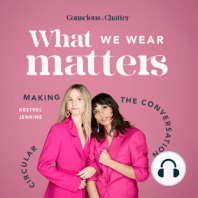19 min listen

Katia Dayan Vladimirova on The Hot Or Cool Institute's new report, what a 1.5 degree wardrobe could look like & questioning how much is enough
Katia Dayan Vladimirova on The Hot Or Cool Institute's new report, what a 1.5 degree wardrobe could look like & questioning how much is enough
ratings:
Length:
50 minutes
Released:
Jan 16, 2023
Format:
Podcast episode
Description
In episode 282, Kestrel welcomes Katia Dayan Vladimirova, a senior researcher at the University of Geneva, to the show. In addition to her research on fashion consumption, sustainability, and degrowth, Katia is the founder and coordinator at the Sustainable Fashion Consumption Network, and recently contributed to the Hot or Cool Institute’s Report – Unfit, Unfair, Unfashionable. “Sufficiency is part of —very much interlinked with degrowth conversations today — it’s about abandoning economic growth in favor of wellbeing and enoughness as a positive vision of the future, in which we are content with enough and are not looking for more all the time.” -Katia I’ve been thinking a lot about the sustainable fashion narrative (over the last decade or so) and as I see it, we’ve seen a few big stages in the conversation – mind you, there are so many more nuanced narratives that have been out there, but these are the narratives I’ve heard the most noise around: Stage 1 – A focus on redirecting your consumption habits. The idea that you can be more sustainable with your wardrobe if you buy differently. The narrative was very much interconnected with capitalism and focused on the notion of BUY THIS, NOT THAT. Stage 2 – A basic understanding that massive corporations are the biggest culprits of carbon emissions and human rights violations in fashion. The narrative shifted a bit away from *blaming the consumer* and a bit toward highlighting the need for brands to change. This also involved an acknowledgement of the important role that legislation can play in transforming the industry. This was when we saw the rise of the fashion activist. Stage 3 – (This is the stage I believe we are currently amidst.) It’s a combination of the previous stages, with greater context and more specific recommendations on HOW to truly make an impact. It involves an understanding that there is not one specific avenue to change the way fashion currently operates – but instead, we need all hands on deck, and multiple avenues working to address the industry’s inequities. This week’s guest was one of the authors of a recent report that came out by the Hot or Cool Institute. I feel like the findings in this report directly assist in providing specific ways that a so-called CONSUMER can transform their behavior to make measurable impacts on climate change (something I’m seeing as an integral part of this Stage 3 we are currently amidst). In the report, it highlights that – “If no other actions are implemented, such as repairing/mending, washing at lower temperatures, or buying second-hand, purchases of new garments should be limited to an average 5 items per year for achieving consumption levels in line with the Paris Agreement – to keep the average global temperature rise below 1.5 degrees Celsius by 2030. This is very exciting – to see a report tell us a target number – to let us know that we can still buy clothing, but if we can all reduce our purchasing to only 5 garments per year, we can stay within planetary boundaries. Tune in to hear more from this week’s guest on HOW MUCH IS ENOUGH? when it comes to our fashion consumption. Quotes & links from the conversation: Hot or Cool Institute’s Report "Unfit, Unfair, Unfashionable: Resizing Fashion for a Fair Consumption Space" Sustainable Fashion Consumption Network, international research network on sustainable fashion consumption "Consumption Corridors in Fashion: Deliberations on upper consumption limits in minimalist fashion challenges", Katia’s article that explores how much is enough “When we’re talking about the key driving force behind the growing emissions in fashion — these are the wealthiest 20%. And we may think that, wealthiest 20%, oh this is somewhere far away from us. But if we look at the numbers — in Germany, to be within the wealthiest 20%, the individual income has to be over 3.2K Euros per month. So, many people who are participating in policy conversations, in research — many people who
Released:
Jan 16, 2023
Format:
Podcast episode
Titles in the series (100)
S01 Episode 01 | INTRODUCTION: INTRODUCTION by Conscious Chatter